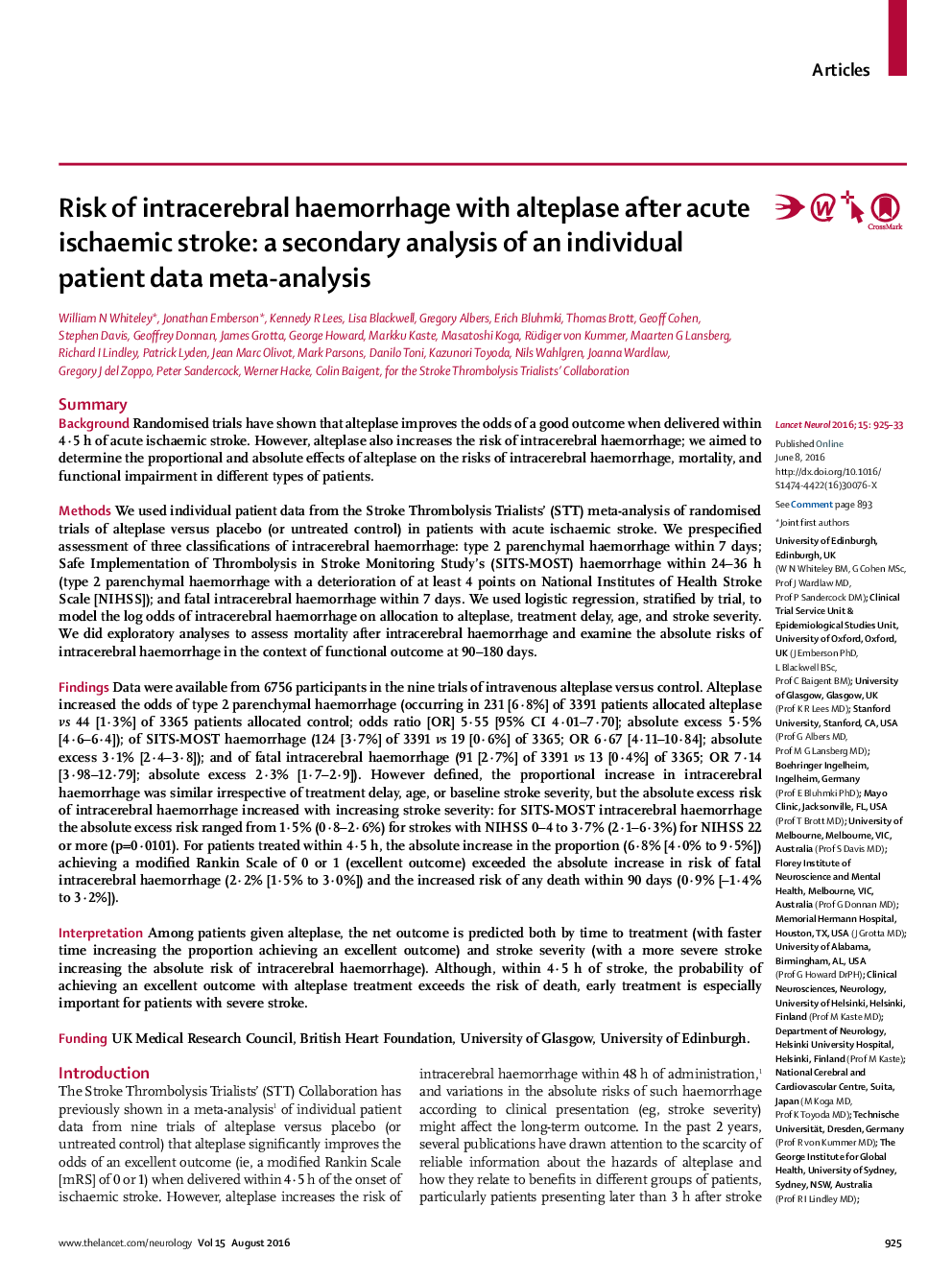| کد مقاله | کد نشریه | سال انتشار | مقاله انگلیسی | نسخه تمام متن |
|---|---|---|---|---|
| 3066365 | 1188065 | 2016 | 9 صفحه PDF | دانلود رایگان |
SummaryBackgroundRandomised trials have shown that alteplase improves the odds of a good outcome when delivered within 4·5 h of acute ischaemic stroke. However, alteplase also increases the risk of intracerebral haemorrhage; we aimed to determine the proportional and absolute effects of alteplase on the risks of intracerebral haemorrhage, mortality, and functional impairment in different types of patients.MethodsWe used individual patient data from the Stroke Thrombolysis Trialists' (STT) meta-analysis of randomised trials of alteplase versus placebo (or untreated control) in patients with acute ischaemic stroke. We prespecified assessment of three classifications of intracerebral haemorrhage: type 2 parenchymal haemorrhage within 7 days; Safe Implementation of Thrombolysis in Stroke Monitoring Study's (SITS-MOST) haemorrhage within 24–36 h (type 2 parenchymal haemorrhage with a deterioration of at least 4 points on National Institutes of Health Stroke Scale [NIHSS]); and fatal intracerebral haemorrhage within 7 days. We used logistic regression, stratified by trial, to model the log odds of intracerebral haemorrhage on allocation to alteplase, treatment delay, age, and stroke severity. We did exploratory analyses to assess mortality after intracerebral haemorrhage and examine the absolute risks of intracerebral haemorrhage in the context of functional outcome at 90–180 days.FindingsData were available from 6756 participants in the nine trials of intravenous alteplase versus control. Alteplase increased the odds of type 2 parenchymal haemorrhage (occurring in 231 [6·8%] of 3391 patients allocated alteplase vs 44 [1·3%] of 3365 patients allocated control; odds ratio [OR] 5·55 [95% CI 4·01–7·70]; absolute excess 5·5% [4·6–6·4]); of SITS-MOST haemorrhage (124 [3·7%] of 3391 vs 19 [0·6%] of 3365; OR 6·67 [4·11–10·84]; absolute excess 3·1% [2·4–3·8]); and of fatal intracerebral haemorrhage (91 [2·7%] of 3391 vs 13 [0·4%] of 3365; OR 7·14 [3·98–12·79]; absolute excess 2·3% [1·7–2·9]). However defined, the proportional increase in intracerebral haemorrhage was similar irrespective of treatment delay, age, or baseline stroke severity, but the absolute excess risk of intracerebral haemorrhage increased with increasing stroke severity: for SITS-MOST intracerebral haemorrhage the absolute excess risk ranged from 1·5% (0·8–2·6%) for strokes with NIHSS 0–4 to 3·7% (2·1–6·3%) for NIHSS 22 or more (p=0·0101). For patients treated within 4·5 h, the absolute increase in the proportion (6·8% [4·0% to 9·5%]) achieving a modified Rankin Scale of 0 or 1 (excellent outcome) exceeded the absolute increase in risk of fatal intracerebral haemorrhage (2·2% [1·5% to 3·0%]) and the increased risk of any death within 90 days (0·9% [–1·4% to 3·2%]).InterpretationAmong patients given alteplase, the net outcome is predicted both by time to treatment (with faster time increasing the proportion achieving an excellent outcome) and stroke severity (with a more severe stroke increasing the absolute risk of intracerebral haemorrhage). Although, within 4·5 h of stroke, the probability of achieving an excellent outcome with alteplase treatment exceeds the risk of death, early treatment is especially important for patients with severe stroke.FundingUK Medical Research Council, British Heart Foundation, University of Glasgow, University of Edinburgh.
Journal: - Volume 15, Issue 9, August 2016, Pages 925–933
